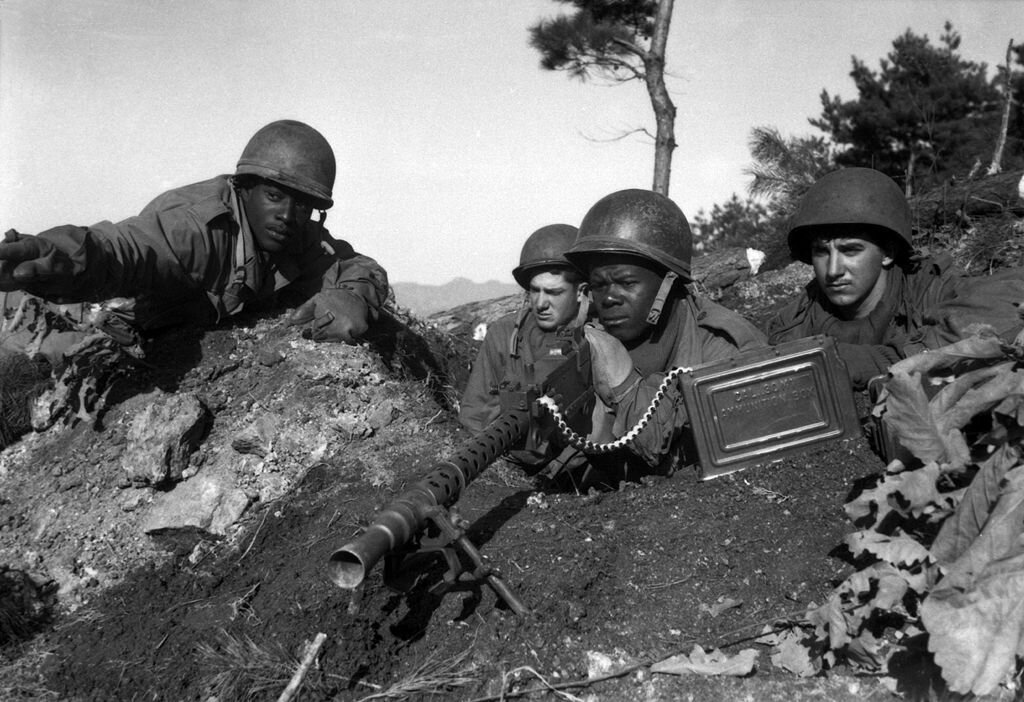The 1950-53 Korean War involved a US-backed South Korea against a communist-backed North Korea. But what lessons can the US learn from the war today? Here, Michael Cho considers this question in the context of the Afghanistan and Iraq Wars of the 21st century.
Members of a M24 tank crew besides the Naktong River front during the Korean War on August 17, 1950.
The Korean War was a war fought between South Korea, formally known as the Republic of Korea, and North Korea, also known as the Democratic People’s Republic of Korea. On June 25, 1950, seventy-five thousand North Korean soldiers crossed the 38th parallel, the line dividing South and North Korea, to spread communist ideals to South Korea. In launching this attack, North Korean troops found South Korea completely unaware and, in many ways, powerless to fight back. Initially, South Korean troops had been driven far south by the North Koreans until the United States assisted them by providing necessary men and supplies through a United Nations sanctioned policing mission.
The Korean War was one of the proxy wars in the Cold War and was fought in an attempt to stop the growth of communism, but when examining the overall cost of the Cold War, while the United States bore a heavy material cost, proxy states like South Korea disproportionately paid the human cost. At the intersection of ideology, commerce and conflict, sits the Korean War and its lessons about the application of power in foreign policy and the costs and consequences of America’s role in the world.
Proxy wars
In many ways, the Korean War became a microcosm of the larger Cold War dynamics that dominated the twentieth century. By engaging in proxy wars across the globe, the United States was able to break down trade barriers and open up different regions of the world to American investment and influence. Ideologically, the United States prevented a possible Soviet global takeover by spreading fear of a communist global takeover; geopolitically, the US implemented their anti-communist strategy through the Truman Doctrine in 1947. The Domino theory, a theory growing out of the Truman Doctrine and the Marshall Plan, stated that if the United States allowed any country to fall to communism, other adjacent countries would soon follow, resulting in a world ruled by communism. The Domino theory thus became a primary justification for United States foreign policy interventions because it predicted a global communist takeover if the United States took no action. Consequently, the United States was active globally “saving” many countries from falling to communism by fighting communism in South Korea. The Truman Doctrine and the Marshall Plan provided the strategy and the tactics to implement the American Cold War mindset globally. In the Domino theory, the United States found a reason to defend democracy in Korea and demonstrate to itself and other democratic allied countries that the United States would not allow communism to threaten their societies; in so doing, proxy wars served to strengthen international commitment to American-led institutions of global governance.
Military aid
The material cost of waging this proxy was significant and represented a strategic shift by the United States to enlarge the scope of its Cold War response under the umbrella of “humanitarian aid.” Prior to the Korean War, the Marshall Plan applied only to economic aid and support; the Marshall Plan did not cover military aid until the commitment to the Korean War was made. By supplying South Korea, who had few supplies and a scarce supply of troops, with imperative supplies and troops to win, the United States helped South Korea hold back communism. South Korea stopped North Korea’s advance in the war and reclaimed lost territory up to, and briefly beyond, the 38th parallel where the initial invasion had started. The United States heavily supplied, manned, and funded the South Koreans. It spent thirty billion dollars during the Korean War and supplied the South Koreans with vehicles such as M4 Sherman tanks, 1,000,000 personnel (consisting of mostly United States soldiers) to the mere South Korean military who had 100,000 personnel and were facing an army of 1,200,000 Chinese and North Korean soldiers. Now heavily supplied, South Korea’s ability to win the war improved dramatically and contrasted sharply with the previous South Korea who had a limited amount of supplies and troops. As the Korean War progressed, the war turned more into a war of attrition, and South Korea was successful because it was the better supplied belligerent.
A trade-off
The Korean War represents a unique glimpse into answers to the question of how much evil is it acceptable to engage in when attempting to do good. The first is that when confronting challenges in foreign policy, nation-states often have only a series of bad options when conducting foreign policy. By fighting for South Korea, the United States successfully stopped the growth of communism in South Korea, but the war ended with around five million Korean casualties and approximately 33,000 American casualties, which highlights the significant human cost that is borne by the peoples living in the geographic region in which the proxy war occurs. Many at the time debated the proper course and conduct of the Korean War, most famously Douglas MacArthur and President Truman; regardless, the decision came down to an abandonment of core humanitarian ideals or a massive cost of human life. As recent events in Afghanistan have shown that dynamic still exists, but with the Cold War context to unify American public opinion, it is unclear to what extent, if any, the United States will make those same choices in the 21st century.
When the United States and South Korea made the choice that the material and human cost was worth the price, it used morality and the language of a humanitarian effort to explain that cost. The United States’ involvement in the Korean War proved a military necessity because US funding was the force driving South Korea forward in the war. In this situation, the United States’ aid was essential because South Korea would have lost the war after the first invasion without support from the United States. However, it was the development of a thriving economy in South Korea (often through very undemocratic means under a series of dictators in the 50s, 60s, and 70s) that created the South Korea of the 21st century. This highlights that the key component that made the American mission to defend the world from the threat of communism successful might have been the investments made in the host-proxy’s economy via the Marshall Plan. The lack of any kind of Marshall Plan-style investment into Afghanistan or Iraq following the invasions of 2001 and 2003, respectively, indicates a lack of willingness to make the same kind of commitment in the 21st century.
In the context of today
The United States’ mission in the world has never been less certain. President Trump’s “America First” foreign policy began deconstructing elements of the WWII alliances the Truman Doctrine and Marshall Plan were built upon. Additionally, at a time when Congress is deadlocked surrounding physical and human infrastructure investment in the domestic United States, the willingness of the United States to make the investments overseas that are truly vital to implementing its foreign policy vision is debatable at best. However, while the outcome might be uncertain and the loss of life could be great, the fate of the two Koreas offers interesting and informative lessons for the United States in the 21st century. South Korea represents a positive example of what can happen when the choice is made to uphold human rights and core democratic ideals despite the human and material cost being high and the outcome uncertain. Based upon the thriving democratic capitalist society now present in South Korea and the stark contrast with the poverty and oppression in North Korea, perhaps the true cost of leadership and the price of freedom becomes apparent. Korea serves as a useful case study for the necessary costs, successful tactics and strategies and consequences of proxy wars in defense of democratic principles.
What do you think are the key lessons for the US from the Korean War? Let us know below.


















